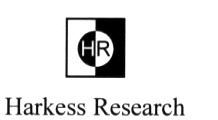
 Wisp
Unification Theory - 4 Wisp Space
Wisp
Unification Theory - 4 Wisp Space
- Home
- About Me
- Reasons why Einstein was wrong
- One-way speed of light experiments
- Hot topic
- Q&A
- ACES - The end of Relativity
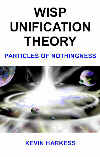
- Book Contents
- Introduction
- 1 Matter,Space and Time
- 2 Symmetry
- 3 Fractals
- 4 Wisp Space
- 5 Gravity
- 6 Electromagnetic Force
- 7 Wisp & S.R: Fundamentals
- 8 Wisp & S.R: Electrodynamics
- 9 Wisp & S.R: Doppler effect
- 10 Wisp & S.R: Relativistic Mechanics
- 11 Big bang
- Appendix A
- Appendix B
- Index A-Z
- Copyright
- Feedback
This page contains the complete chapter. To download the new 2011 2nd edition of wisp unification theory go to the homepage.
4
Wisp Space
Here we will see our perception of reality reverse. What we think of
as ‘emptiness’ is in fact full of ‘ether’ particles
called wisps (weightless one-state particles). And what we think of as
solid is created by their absence. What we think of as ‘normal flat
space’ or ‘void’ occurs when wisp packing is at its maximum.
The idea of an ether medium is not new. So why now should an ether theory
be taken seriously? Well, it gives the right answers; it matches special
relativity’s predictions; and it gives a simple answer to the question
‘What causes gravity?’
4.1 Wisp space’s structure
4.1.1 States of space
Wisp space is in a state of being either empty or full, or in an intermediate
state. For example:
- Empty space contains nothing, and wisp theory refers to it
as
‘zero-state space’. It has no energy and does not transmit force. It does, however, play a key role in creating matter and three of the four fundamental forces of nature. - Full space is densely packed with wisps and is referred to
as
‘one-state space’ or ‘flat space’. The strong nuclear force binds wisp together – the only force of nature that exists as a real property of the wisp. Wisps can move in one-state space, but generally remain fixed within its lattice structure. - Intermediate-state space is a combination of one-state and
zero-state space. This creates regions with diverse properties such as: matter-fractals, curved space, magnetism, gravitational compression and tension forces, and electric charge.
4.1.2 Wisps
Wisps are the smallest fundamental particles in nature. They have specific
size and mass. Although they possess mass, they are unaffected by gravitational
force since the gravitational effect is caused by curved wisp space and
does not exist as a separate substance. No antiwisp particle exists.
4.1.3 Matter-fractals
Wisp theory is an ether theory with a unique property – matter-fractals,
which I believe, form the fundamental particles of nature – the quarks
and leptons.
Spherical fractal structures form within wisp space around regions of
zero-state space (‘empty’ zero-state spheres). Gaps appear between
neighbouring wisps as they wrap around the zero-state sphere. The gaps
stretch the strong nuclear binding force, and this gives the fractal structure
enormous strength. Once formed, the matter-fractal is able to move effortlessly
through wisp space, since equal and opposite forces form across its surface.
As it moves, wisps are displaced, creating transverse wave patterns –
quantum waves.
Figure 4.1 shows a cross-section view of a matter-fractal. Its scale is
not proportional to the wisp’s size, as many millions more would
be required to form each structure.
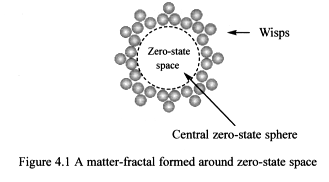
A matter-fractal’s size is dependent on the radius of its central
zero-state sphere. This is crucial in determining the type of fundamental
particle formed. Since matter-fractals form around the surface of zero-state
spheres, a particle’s mass is proportional to the surface area of
its zero-state sphere, and its density will vary inversely proportional
to the distance from the sphere. The thickness of a matter-fractal’s
layers is proportional to its zero-state sphere’s radius. A specific
number of wisps get locked into its structure, giving it its unique mass.
The formation of matter-fractal structures is based upon simple processes
that utilise the principle of least action – wisp movements are minimised
while the fractal shapes adjust for maximum stability. As stated earlier,
it would be almost impossible to use conventional mathematics to calculate
the fractal patterns, since the numbers of wisps involved is too high.
The use of cellular automata could provide the answer. Instead of solving
complex mathematics, computers running automata programs might determine
which fractal patterns form in wisp space. Patterns that produce best
stability for lease movement could then be selected for comparison with
the known masses of the fundamental particles.
The ‘stretched’ strong nuclear force gives the fractal structure
extra strength, allowing it to move effortlessly through wisp space and
survive small collisions. However, if the matter-fractal gets too large,
it becomes unstable and can quickly break up into smaller more stable
structures. Larger fractal structures are more prone to break during high-speed
collisions.
Figure 4.2 shows a matter-fractal stationary in wisp space. Its presence
breaks the symmetry of flat one-state space. One-state space is forced
to wrap around the fractal structure, but it does not have the strength
to break it.
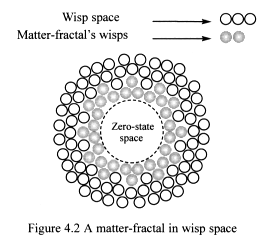
As matter-fractals move, they displace wisps – transverse displacement
– to either side by the actions of equal and opposite forces, creating
quantum wave patterns in wisp space. Only the matter-fractal’s shape
is preserved as it moves through wisp space; the wisps that form it are
continuously replaced.
A few months after I discovered this property of matter, I asked my wife
to explain to me what she understood about this new idea. She replied
‘Matter is particles of nothingness.’ She is right, without
nothingness (zero-state space) matter would not exist.
4.2 Early ether theories
4.2.1 René Descartes
The seventeenth century philosopher and mathematician René Descartes
thought that the universe was filled with small invisible particles or
‘corpuscles’ that moved effortlessly in whirlpool vortices.
Opaque matter floated in this medium and was caught up by the whirlpools.
Once started, their motions would continue and the energy in the universe
would stay constant.
4.2.2 James Clerk Maxwell
In 1856 James Clerk Maxwell showed that an incompressible fluid behaved
the same way as the fields that produce magnetic and electric effects.
In his model, magnetism is caused by vortices in the fluid and electric
current contained in fluid cells.
With elasticity added to his model, in 1864 he developed the fundamental
equations of electromagnetism and found that transverse electromagnetic
waves could move at the speed of light through the hypothetical ether
medium.
Maxwell discovered that electromagnetic waves possessed magnetic and electric
fields that oscillated at right angles to each other and to the direction
of wave propagation. It was difficult to imagine how a fluid could produce
these effects, and so the link between his equations of electromagnetism
and the ether was lost.
Maxwell developed his theory on the basis that electromagnetic fields
transfer force from one point to a neighbouring point, in a field that
has properties that may be likened to an elastic fluid. Yet his equations
of electromagnetism are purely mathematical in nature and have no direct
link to a fluid medium. His work certainly supports the existence of the
ether, but it does not prove it exists; more proof is needed.
4.2.3 J.J. Thomson
Sir Joseph John Thomson carried out an analysis of vortex rings in 1883
and theorised that atoms might be vortex rings within the hypothetical
electromagnetic ether.
4.2.4 Michelson and Morley
An experiment conducted in 1887, by Albert Michelson and Edward Morley,
to measure the velocity of the Earth through the ether, gave good reason
to believe that the ether did not exist. If it did, then surely the motion
of the Earth through it would give a positive result, but it gave a negative
result – zero!
The pressure was on to explain the findings of the experiment or simply
dismiss the notion of the ether.
4.2.5 Insufficient proof
There is no direct proof that the ether does or does not exist. Current
theories tend to dismiss it rather than include it.
Wisp theory is built upon wisp space – a type of ether medium, which
is responsible for creating particles and transmitting force between them.
Without it force would not propagate. Later we will see that it is the
inability of force to transmit through zero-state space ‘emptiness’
that causes the effect of gravitation.
Proof of the existence of the ether requires abandonment or major modification
to Einstein’s special theory of relativity, and an explanation to
why the Michelson–Morley experiment gave a null result. A revised
relativity theory and an explanation are given by wisp theory.
4.3 Waves in wisp space
Two types of travelling wave are associated with motion through wisp space:
transverse waves and longitudinal waves. As they move through wisp space,
wisps are displaced in transverse and longitudinal directions respectively,
and their respective wavelengths are lambda t and lambda l. They share
properties commonly associated with waves: diffraction, reflection, and
refraction.
By way of analogy, we can compare them with water waves: Ripples (transverse
waves) moving across the water’s surface are like electromagnetic
waves or matter-fractal’s quantum waves. And sound waves (longitudinal
waves) that travel through water are like longitudinal waves that travel
through wisp space.
Just as sound waves in water travel much faster than surface ripples,
so we can expect wisp longitudinal waves to travel faster than wisp transverse
waves. The fastest transverse wave in wisp space is light, so wisp longitudinal
waves should travel faster than light!
4.3.1 Transverse waves
As they travel through wisp space they displace wisps in directions that
are at right angles to the wave’s motion (Figure 4.3), and wave speeds
are less than or equal to light-speed through wisp space. Types include:
matter-fractal’s quantum waves, electromagnetic waves, gravitational
waves, and de Broglie waves – first proposed in 1924 by Louis de
Broglie.
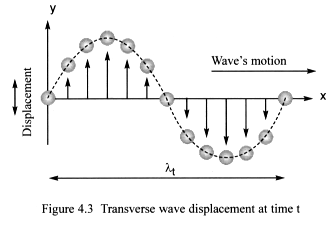
4.3.2 Longitudinal waves
Displacement takes place in the same direction in which the wave travels
– similar to sound waves travelling through air or water (Figure
4.4).
The front half of the wave compresses wisp space as it passes through
it. This is followed by a half cycle of rarefaction, which stretches wisp
space. Pressure and density changes that occur in wisp space are incredibly
small, but the wave speed is very fast – possibly ten times the speed
of light.
Wisp theory predicts the existence of faster-than-light longitudinal waves,
but this is a new concept and scientists have no knowledge of it. These
waves are responsible for meteors’ shock waves (discussed later),
longitudinal gravitational waves (following supernova events) and possibly
quantum entanglement.
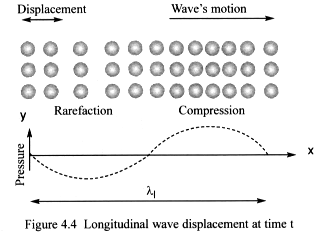
4.3.3 EPR Paradox
Longitudinal waves that travel faster than the speed of light may offer
an explanation for the strange findings of quantum entanglement.
In 1935, Einstein, with support from Boris Podolsky and Nathan Rosen,
proposed a thought experiment referred to as the ERP Paradox. If Einstein
were right then quantum theory would be incomplete.
Consider an example where two subatomic particles interact and are moved
a great distance apart. The particles are correlated so that the action
of one affects the behaviour of the other. When measurements are made
simultaneously on the separated particles, the results should be independent
of each others quantum state; since they cannot share information, as
it would need to travel between them at a speed greater than that of light.
Experiments carried out to test this proposal have proven Einstein wrong.
It appears that separated particles remain entangled and do somehow communicate
their information at speeds faster than that of light. Einstein referred
to this as ‘spooky action at a distance’, and quantum mechanics
argue that these states are non-local and so there is no paradox! But
if information is communicated at a speed faster than light, does that
not undermine special relativity’s claim that nothing travels faster
than light?
4.4 Matter-fractal’s motion through wisp space
As transverse waves travel through wisp space, the wisps are moved from
side to side, they do not travel along with the wave. The wave carries
only its shape, energy and momentum.
A matter-fractal travels through wisp space as a transverse wave packet.
Wisps that make up the matter-fractal play a similar role to wisps that
make up a transverse wave’s shape, only here the matter-fractal’s
shape is much more complex. As the matter-fractal travels through wisp
space, a series of equal and opposite forces move wisps in directions
that are at right angles to the matter-fractal’s direction of motion.
All wisps are displaced by the matter-fractal and none travels along with
it. Matter-fractals carry fractal shape, energy and momentum.
Transverse wisp displacement can be interpreted mathematically as a Fourier
series that forms the wave functions of quantum mechanics. By way of analogy,
a circle can be constructed from the points of intersection of an infinite
number of tangent lines. But that does not mean that all circles must
have an infinite number of tangents attached to them. Similarly we can
represent a matter-fractal as an infinite number of sine waves forming
a quantum wave packet. But that does not mean that matter-fractals are
made from sine waves. It is just that their behaviour in wisp space can
be modelled by an infinite number of waves summed together to form a wave
packet, since matter-fractals replicate these patterns as they travel
through wisp space.
Figure 4.5 shows wisp space displacement resulting from matter-fractal’s
motion. Note that the wisps that previously made up the fractal have returned
to their original positions, and new wisps now form the matter-fractal’s
pattern.
Matter would be unable to move through wisp space as a transverse wave
packet if it did not possess zero-state space. This is needed to form
stable matter-fractal structures.
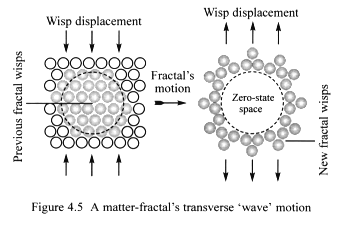
4.5 Absolute frames of reference
A single absolute frame of reference is an abstract notion that in practice
does not exist.
Any frame of reference in which wisps are stationary can for practical
purposes be considered as absolute. It is theoretically possible for several
absolute frames of reference to be in relative motion, so long as they
are physically isolated. Otherwise they would combine to form a single
absolute frame.
4.5.1 Local absolute frames of reference
It is likely that between any two local frames – separated by a great
distance – there may be a small relative motion between them caused
by movement of wisp space. It is perfectly reasonable to consider both
local frames as absolute in their own right and so ignore negligible relative
motion effects.
4.6 Newton’s laws of motion
At speeds much less than light speed, matter-fractals move through one-state
space according to Newton’s three laws of motion. These laws of motion
are as follows:
4.6.1 Newton’s first law of motion
A body continues in a state of rest or uniform motion in a straight line
unless it is acted upon by external forces.
At rest a matter-fractal is stationary in an absolute one-state space.
There is no motion whatsoever between the fractal and the surrounding
wisps, so quantum waves are absent.
When a matter-fractals moves through one-state space, it displaces wisps
at right angles to its motion – transverse wave motion displacement
– creating quantum wave patterns. There are no friction forces acting
to slowing it down – wisp space is inviscid (frictionless). Equal
and opposite forces establish across its surface allowing it to move effortlessly
through wisp space in accordance with Newton’s first law of motion.
4.6.2 Newton’s second law of motion
The rate of change of momentum of a moving body is proportional to and
in the same direction as the force acting on it, i.e. F = d(mv)/dt,
where F is the applied force, v is the velocity of the body,
and m its mass. If the mass remains constant, F = mdv/dt
or F = ma, where a is the acceleration.
When force acts on a matter-fractal it causes distortion to its shape. But because its shape is held together by the nuclear binding force, it is able share the effect of the applied force among all wisps in its fractal structure. These wisps have inertia and react by accelerating in directions at right angles to the bodies motion; the quicker they move the faster the matter-fractal shape moves.
4.6.3 Newton’s third law of motion
If one body exerts a force on another, there is an equal and opposite
force, called a reaction, exerted on the first body by the second.
We would expect forces acting between particles to be equal and opposite,
and this is always the case in wisp theory.
However, there is one surprise, due to the fact that in wisp theory transverse
force transmits at the speed of light. The effect of force on particles
travelling at near-light speed reduces. This makes it harder to speed
up and slow down fast-moving particles. We cover this later (Sections
7.14.2 accelerating subatomic particles and 7.14.3 decelerating subatomic
particles).
Home --
About Me -- Reasons
why Einstein was wrong -- One-way
speed of light experiments -- Hot
topic --
Q&A -- ACES
- The end of Relativity --
Book Contents -- Introduction
-- 1 Matter,
Space and Time -- 2
Symmetry -- 3
Fractals -- 4 Wisp Space -- 5
Gravity -- 6 Electromagnetic
Force --
7 Wisp & S.R: Fundamentals
-- 8 Wisp & S.R: Electrodynamics
-- 9 Wisp
& S.R: Doppler effect -- 10
Wisp & S.R: Relativistic Mechanics --
11 Big bang -- Appendix
A -- Appendix B -- Index
A-Z -- Copyright -- Feedback